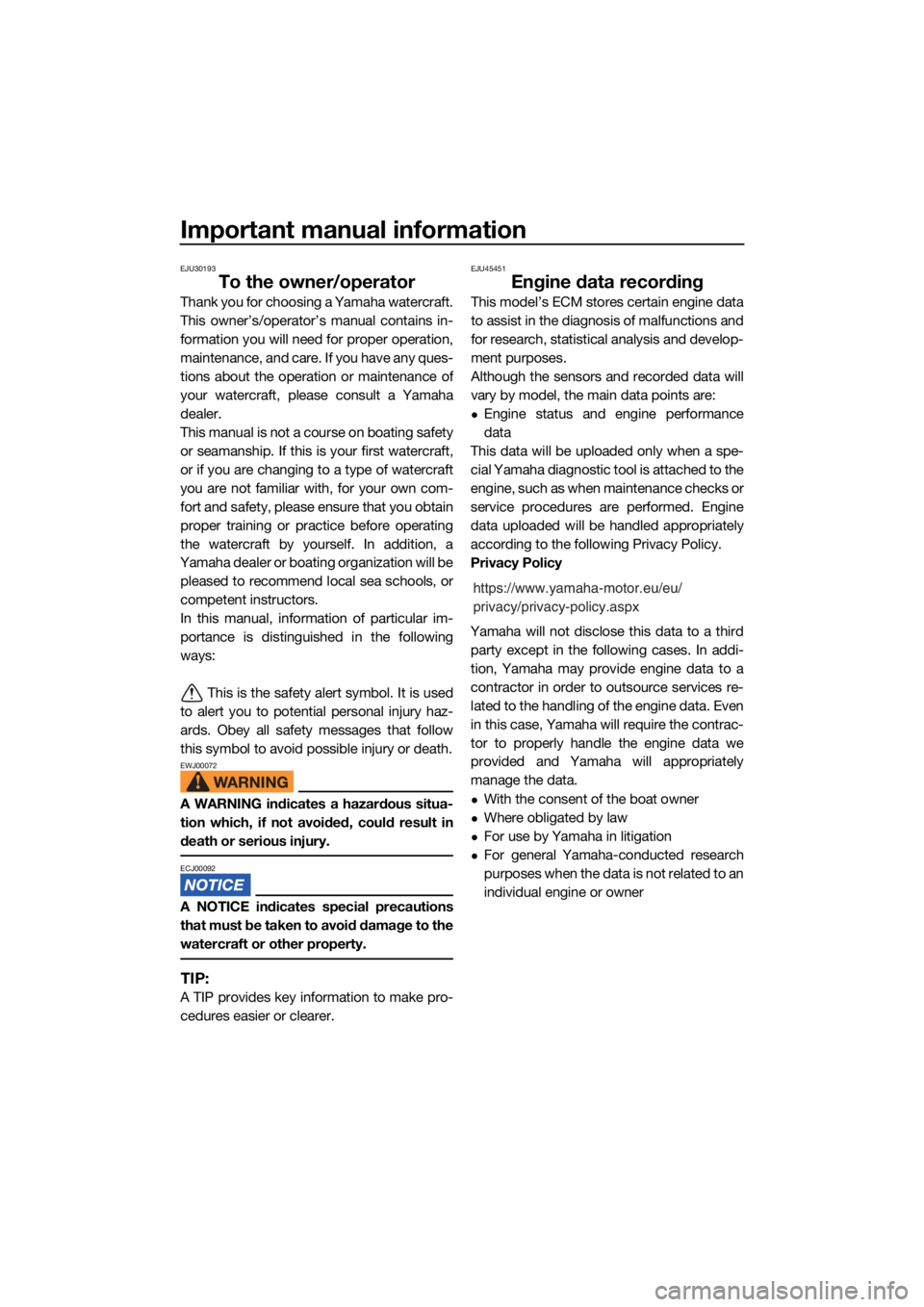maintenance YAMAHA EXR 2021 Owners Manual
[x] Cancel search | Manufacturer: YAMAHA, Model Year: 2021, Model line: EXR, Model: YAMAHA EXR 2021Pages: 98, PDF Size: 4.56 MB
Page 4 of 98

Important manual information
EJU30193
To the owner/operator
Thank you for choosing a Yamaha watercraft.
This owner’s/operator’s manual contains in-
formation you will need for proper operation,
maintenance, and care. If you have any ques-
tions about the operation or maintenance of
your watercraft, please consult a Yamaha
dealer.
This manual is not a course on boating safety
or seamanship. If this is your first watercraft,
or if you are changing to a type of watercraft
you are not familiar with, for your own com-
fort and safety, please ensure that you obtain
proper training or practice before operating
the watercraft by yourself. In addition, a
Yamaha dealer or boating organization will be pleased to recommend local sea schools, or
competent instructors.
In this manual, information of particular im-
portance is distinguished in the following
ways:
This is the safety alert symbol. It is used
to alert you to potential personal injury haz-
ards. Obey all safety messages that follow
this symbol to avoid possible injury or death.
EWJ00072
A WARNING indicates a hazardous situa-
tion which, if not avoided, could result in
death or serious injury.
ECJ00092
A NOTICE indicates special precautions
that must be taken to avoid damage to the
watercraft or other property.
TIP:
A TIP provides key information to make pro-
cedures easier or clearer.
EJU45451
Engine data recording
This model’s ECM stores certain engine data
to assist in the diagnosis of malfunctions and
for research, statistical analysis and develop-
ment purposes.
Although the sensors and recorded data will
vary by model, the main data points are:
Engine status and engine performance
data
This data will be uploaded only when a spe-
cial Yamaha diagnostic tool is attached to the
engine, such as when maintenance checks or
service procedures are performed. Engine
data uploaded will be handled appropriately
according to the following Privacy Policy.
Privacy Policy
Yamaha will not disclose this data to a third party except in the following cases. In addi-
tion, Yamaha may provide engine data to a
contractor in order to outsource services re-
lated to the handling of the engine data. Even
in this case, Yamaha will require the contrac-
tor to properly handle the engine data we
provided and Yamaha will appropriately
manage the data.
With the consent of the boat owner
Where obligated by law
For use by Yamaha in litigation
For general Yamaha-conducted research
purposes when the data is not related to an
individual engine or owner
https://www.yamaha-motor.eu/eu/
privacy/privacy-policy.aspx
UF4L72E0.book Page 2 Thursday, June 18, 2020 1:29 PM
Page 7 of 98

Table of contents
Learning to operate your watercraft ...................................... 59
Riding position ................................. 60
Launching the watercraft ................. 60
Starting the engine on water ............ 60
Stopping the engine ......................... 61
Leaving the watercraft...................... 61
Operating the watercraft .................. 61
Turning the watercraft ...................... 62
Stopping the watercraft ................... 63
Operating the watercraft in reverse or neutral ...................................... 64
Boarding the watercraft ................... 65
Starting off........................................ 67
Capsized watercraft ......................... 68
Beaching and docking the watercraft ...................................... 69
Operating in weeded areas .............. 69
After removing the watercraft from the water ....................................... 70
Care and storage............................. 71Post-operation care ...................... 71
Flushing the cooling water
passages....................................... 71
Cleaning the watercraft .................... 72
Battery care ...................................... 72
Long-term storage ........................ 74
Cleaning ........................................... 74
Lubrication ....................................... 74
Rustproofing..................................... 75
Maintenance .................................... 77 Maintenance.................................. 77
Periodic maintenance chart ............. 78
Engine oil and oil filter ...................... 80
Specifications .................................. 81Specifications................................ 81
Trouble recovery ............................. 82 Troubleshooting ............................ 82
Troubleshooting chart ...................... 82
Emergency procedures ................ 85
Cleaning the jet intake and
impeller ......................................... 85
Raising the reverse gate .................. 86
Jumping the battery ......................... 86
Towing the watercraft....................... 87
Submerged watercraft ..................... 87
Index................................................. 89
UF4L72E0.book Page 2 Thursday, June 18, 2020 1:29 PM
Page 25 of 98

Safety information
18
EJU30992
Enjoy your watercraft responsibly
You share the areas you enjoy when riding
your watercraft with others and with nature.
So your enjoyment includes a responsibility
to treat these other people, and the lands,
waters, and wildlife with respect and courte-
sy.
Whenever and wherever you ride, think of
yourself as the guest of those around you.
Remember, for example, that the sound of
your watercraft may be music to you, but it
could be just noise to others. And the exciting
splash of your wake can make waves others
won’t enjoy.
Avoid riding close to shoreline homes and
waterfowl nesting areas or other wildlife ar-
eas, and keep a respectful distance from fish-
ermen, other boats, swimmers, and
populated beaches. When travel in areas like
these is unavoidable, ride slowly and obey all
laws.
Proper maintenance is necessary to ensure
that the exhaust emission and sound levels of
your watercraft will continue to be within reg-
ulated limits. You have the responsibility to
make sure that the recommended mainte-
nance in this owner’s/operator’s manual is
carried out.
Remember, pollution can be harmful to the
environment. Do not refuel or add oil where a
spill could cause damage to nature. Remove
your watercraft from the water and move it
away from the shoreline before refueling. Dis-
pose of water and any fuel and oil residue in
the engine compartment according to local
regulations. And keep your surroundings
pleasant for the people and wildlife that share
the waterways: don’t litter. When you ride responsibly, with respect and
courtesy for others, you help ensure that our
waterways stay open for the enjoyment of a
variety of recreational opportunities.
UF4L72E0.book Page 18 Thursday, June 18, 2020 1:29 PM
Page 81 of 98

Care and storage
74
(2) If the battery terminals are dirty or cor-roded, clean them using a wire brush.
(3) Apply water-resistant grease to the bat- tery terminals.
(4) Store the battery in a cool, dry place. NOTICE: Storing the battery in an un-
charged condition can cause perma-
nent battery damage. Check the
battery periodically.
[ECJ00103]
To install the battery:
(1) Place the battery in the battery compart- ment and hook the battery bands onto
the holders.
(2) Connect the positive (+) battery lead (red) to the positive (+) battery terminal.
NOTICE: Reversal of the battery leads
will damage the electrical parts.
[ECJ00262]
(3) Connect the negative (–) battery lead (black) to the negative (–) battery termi-
nal.
(4) Make sure that the battery is securely held in place.
EJU33493
Long-term storageEWJ00331
Always place the watercraft upright in a
horizontal position when storing it, other-
wise fuel could leak out into the engine or
engine compartment, which could create
a fire hazard.
Storage for long periods of time, such as win-
ter storage, requires preventive maintenance
to ensure against deterioration. It is advisable
to have the watercraft serviced by a Yamaha
dealer prior to storage.
However, the following procedures can be
performed easily by the owner.
EJU40763Cleaning
(1) Flush the cooling water passages. (See
page 71 for information on flushing the
cooling water passages.)
TIP:
If you will be storing the watercraft for a pro-
longed period, such as winter storage, top off
the fuel tank with fresh gasoline and add fuel
stabilizer and conditioner to the fuel tank ac-
cording to the manufacturer’s instruction be-
fore starting the engine.
(2) Clean the watercraft. (See page 72 for in-formation on cleaning the watercraft.)
Wax the hull with a non-abrasive wax.
EJU43663Lubrication
To keep moving parts sliding or rotating
smoothly, lubricate them with water-resistant
grease.
1Battery terminal
Recommended water-resistant grease:
YAMALUBE MARINE
GREASE/Yamaha Grease A
1
Recommended water-resistant grease:YAMALUBE MARINE GREASE /
Ya m a h a G r e a s e A
UF4L72E0.book Page 74 Thursday, June 18, 2020 1:29 PM
Page 84 of 98

Maintenance
77
EJU33769
Maintenance
Periodic checks and lubrication will keep
your watercraft in the safest and most effi-
cient condition possible. Therefore, make
sure to carry out the periodic maintenance.
Safety is an obligation of the watercraft own-
er. Proper maintenance must be carried out
to keep the exhaust emission and sound lev-
els within the regulated limits. The most im-
portant points of watercraft inspection and
lubrication are explained on the following
pages.
See a Yamaha dealer for genuine Yamaha re-
placement parts and optional accessories
designed for your watercraft.
Remember, failures that are the result of the
installation of parts or accessories which are
not qualitatively equivalent to genuine
Yamaha parts are not covered by the limited warranty.
Maintenance, replacement, or repair of
the emission control devices and system
may be performed by any marine SI engine
repair establishment or individual. War-
ranty repair, however, must be performed
at an authorized Yamaha marine dealer-
ship.
EWJ00312
Be sure to turn off the engine when you
perform maintenance unless otherwise
specified. If you are not familiar with ma-
chine servicing, this work should be done
by a Yamaha dealer or other qualified me-
chanic.
UF4L72E0.book Page 77 Thursday, June 18, 2020 1:29 PM
Page 85 of 98

Maintenance
78
EJU43101Periodic maintenance chart
The periodic maintenance chart gives general guidelines for periodic maintenance. Have a
Yamaha dealer perform the checks in the following chart. However, maintenance may need to be performed more frequently depending on your operating conditions. If you have any
questions, consult a Yamaha dealer.
This “ √” mark indicates items to be checked and serviced by a Yamaha dealer.
Item OperationInitial Thereafter every
Page
10 hours 50 hours
or 12
months *1 100
hours or 12
months *1 200
hours or 24
months *1
Fuel line Check fuel hoses and
clamps
√
—
Fuel filler cap/Wa-
ter separator Check O-rings for cracks
and deformation
√
—
Fuel tank Check installation and
straps
√
—
Water inlet strainer Check for clogs and dam-
age
√
—
Cooling water hos-
es Check for damage and
leakage, and check
clamps
√
—
Engine oil Replace √√ 80
Oil filter Replace √80
Spark plugs Check √√ —
Battery Check state of charge,
terminals and bands
√
—
Battery leads Check terminals √—
Steering master Check operation and for
looseness
√√
—
Steering cable Check exterior and con-
nections, and lubricate
√
—
Shift rod and re-
verse gate Check exterior and con-
nections, and lubricate
√
—
Air filter element Check for damage and
dirt
√
—
Air intake hoses Check for damage, and
check clamps
√
—
Throttle body Lubricate throttle valve √—
Exhaust system Check for exhaust leak-
age, and check hoses and
clamps √
—
Breather hose Check
breather hose and
clamps √
—
UF4L72E0.book Page 78 Thursday, June 18, 2020 1:29 PM
Page 86 of 98

Maintenance
79
*1: Whichever comes first.
*2: Check every 200 hours.
Perform the pre-operation checks and post-operation checks before performing periodic
maintenance.
ImpellerCheck for bends, dam-
age, and foreign material
√
—
Jet thrust nozzle Check movement, and lu-
bricate
√
—
Jet vacuum bilge Check hoses for clogs
and damage, check
clamps, and clean bilge
strainer
√
—
Stern drain plugs Check O-rings √—
Anode Check for corrosion, and
clean
√
*2 —
Valve clearance Check and adjust √ *2 —
Rubber coupling Check for cracks, inden-
tations, looseness, and
noise √
—
Engine mount Check for damage and
peeling
√
—
Item Operation
Initial Thereafter every
Page
10 hours 50 hours
or 12
months *1 100
hours or 12
months *1 200
hours or 24
months *1
UF4L72E0.book Page 79 Thursday, June 18, 2020 1:29 PM
Page 87 of 98

Maintenance
80
EJU36943Engine oil and oil filterEWJ00341
Engine oil is extremely hot immediately af-
ter the engine is turned off. Coming in con-
tact with or getting any engine oil on your
clothes could result in burns.
ECJ00992
Do not run the engine with too much or not
enough oil in the engine, otherwise the en-
gine could be damaged.
It is recommended to have a Yamaha dealer
change the engine oil and the engine oil filter.
However, if you choose to change the oil and
filter on your own, consult a Yamaha dealer.
UF4L72E0.book Page 80 Thursday, June 18, 2020 1:29 PM
Page 96 of 98

89
Index
A
After removing the watercraft from the water ..................................................... 70
B
Battery care.............................................. 72
Battery checks ......................................... 53
Battery, jumping....................................... 86
Beaching and docking the watercraft ...... 69
Bilge water check..................................... 53
Bilge water, draining ................................ 46
Bilge water, draining on land ................... 46
Bilge water, draining on water ................. 47
Boarding alone ......................................... 65
Boarding and starting off from a dock ..... 68
Boarding the watercraft ........................... 65
Boarding with passenger(s) ..................... 66
Bow eye ................................................... 38
Bow storage compartment ...................... 38
Builder’s plate ............................................ 2
C
Capsized watercraft ................................. 68
Check engine warning ............................. 35
Cleaning ................................................... 74
Cleaning the watercraft ............................ 72
Cleat ......................................................... 38
Cooling water pilot outlet ......................... 26
Cooling water pilot outlet check .............. 57
Craft Identification Number (CIN)............... 1
Cruising limitations................................... 10
E
Emergency procedures ............................ 85
Engine break-in ........................................ 49
Engine compartment check ..................... 52
Engine idling speed check ....................... 58
Engine oil ................................................. 44
Engine oil and oil filter .............................. 80
Engine oil level check............................... 53
Engine oil requirements ........................... 44
Engine overheat warning ......................... 34
Engine serial number ................................. 1
Engine shut-off cord (lanyard) check ....... 55
Engine shut-off switch ............................. 24
Engine stop switch................................... 24
Engine unit check..................................... 53
Enjoy your watercraft responsibly............ 18 Equipment ................................................ 36
F
Fire extinguisher check ............................ 56
Fire extinguisher holder............................ 41
Fire extinguisher holder checks ............... 56
Flushing the cooling water passages....... 71
Fuel .......................................................... 42
Fuel level check........................................ 52
Fuel level meter ........................................ 33
Fuel level warning..................................... 34
Fuel requirements .................................... 42
Fuel system checks ................................. 52
G
Getting to know your watercraft .............. 59
Glossary, watercraft ................................. 19
Glove compartment ................................. 39
H
Handgrip .................................................. 36
Hazard information................................... 14
Hood check .............................................. 57
Hour meter and voltmeter ........................ 32
Hull and deck check ................................ 56
I
Identification numbers ............................... 1
Information display................................... 31
J
Jet intake and impeller, cleaning.............. 85
Jet intake checks ..................................... 56
Jet thrust nozzle and reverse gate
check .................................................... 56
Jumper cables, connecting ...................... 86
L
Labels, important ....................................... 4
Labels, other .............................................. 8
Labels, warning .......................................... 5
Launching the watercraft ......................... 60
Learning to operate your watercraft......... 59
Leaving the watercraft.............................. 61
Limitations on who may operate the watercraft ................................................ 9
Long-term storage ................................... 74
Lubrication ............................................... 74
M
Main components, location of ................. 20
Maintenance............................................. 77
UF4L72E0.book Page 89 Thursday, June 18, 2020 1:29 PM
Page 97 of 98

Index
90
Manufactured date label ............................ 2
Model information ...................................... 2
Multifunction information center .............. 31
Multifunction information center check ... 57
O
Oil pressure warning ................................ 34
Operating in weeded areas ...................... 69
Operating the watercraft .......................... 61
Operating the watercraft in reverse or neutral ................................................... 64
Operating your watercraft ........................ 59
Operation requirements ........................... 11
P
Periodic maintenance chart ..................... 78
Post-launch checks ................................. 57
Post-operation care ................................. 71
Pre-launch checks ................................... 52
Pre-operation check points ..................... 52
Pre-operation checklist ............................ 50
Primary Identification (PRI-ID) number ...... 1
R
Raising the reverse gate .......................... 86
Reboarding grip ....................................... 37
Reboarding step ...................................... 37
Recommended equipment ...................... 13
RiDE lever................................................. 25
RiDE lever checks .................................... 54
Riding position ......................................... 60
Rustproofing ............................................ 75
S
Safe boating rules .................................... 17
Safety equipment check .......................... 56
Seat .......................................................... 36
Seat storage compartment ...................... 40
Shift indicator ........................................... 32
Shift system ............................................. 28
Shift system check................................... 58
Speedometer ........................................... 31
Start switch .............................................. 24
Starting off ............................................... 67
Starting off from a trailer .......................... 68
Starting the engine on water .................... 60
Steering system ....................................... 25
Steering system checks ........................... 54
Stern drain plug checks ........................... 56 Stern eyes ................................................ 38
Stopping the engine ................................. 61
Stopping the watercraft ........................... 63
Storage compartment checks.................. 56
Storage compartments ............................ 38
Submerged watercraft ............................. 87
Switch checks .......................................... 55
T
Tachometer .............................................. 32
Throttle lever ............................................ 25
Throttle lever checks ................................ 55
Towing the watercraft .............................. 87
Transporting on a trailer ........................... 48
Troubleshooting ....................................... 82
Troubleshooting chart .............................. 82
Turning the watercraft .............................. 62
W
Wakeboarding and water-skiing .............. 16
Water separator ....................................... 26
Water separator check ............................. 53
Watercraft characteristics ........................ 14
Watercraft control functions..................... 24
Watercraft operation functions ................ 28
UF4L72E0.book Page 90 Thursday, June 18, 2020 1:29 PM